God and the Sun: The Writing at Göbekli Tepe
By Robert M. Schoch, with Catherine Ulissey
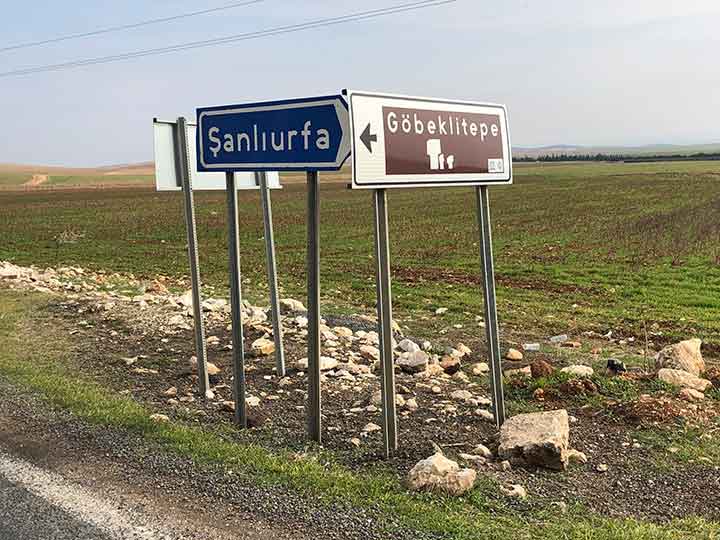
Posted 6 April 2020
(Our apologies for having to mark the copyright of our photos below as we have, but we have had so many images stolen from us through the years it sometimes leaves us feeling mugged. It costs a great deal to fly to these locations to photograph, film, and research. Thank you for your understanding.)
- - - - -
Traditional historians and archaeologists have often pointed to three major distinguishing
characteristics by which one can identify true civilization
: 1) Monumental stone architecture,
2) Settled urban (city) life, and 3) Writing. Prehistoric
is often equated with a society being
pre-literate
; if they do not have any written inscriptions or records, then they do not have a
true recorded history
and are both pre-historic
and pre-civilized
.
Furthermore, according to conventional status quo thinking, writing was first invented
just prior to around 3000 BCE in Sumer and Egypt; therefore, we can date the onset of true
civilization to this time. However, over 6000 years earlier in Northern Mesopotamia we find the
incredibly sophisticated site of Göbekli Tepe. Many mainstream historians are hesitant to apply
the label of true civilization
to the builders of Göbekli Tepe, but why?
Göbekli Tepe is characterized by beautifully carved monumental stone architecture; in particular, T-shaped pillars set in circles or rings (see the banner image above for an overview). To create such structures, we can hypothesize that some form of urban population must have existed in the area, but so far it has not been found. I would point out, however, that the structures the people lived in may not have been stone; rather, they could have been constructed of wood, mudbrick, or other perishable materials. In analogy, the cities that accompanied the pyramids, temples, and other monumental stone structures of dynastic Egypt thousands of years later have left few traces. Or perhaps the city of the Göbekli Tepe people still exists and is now referred to as the city of Urfa (Şanlıurfa), but it is covered over by 12,000 years of more recent habitation. The site of Göbekli Tepe is not far from modern Urfa, and during road work and other construction projects in Urfa, very ancient archaeological remains are often found, including remains going back to Göbekli Tepe times.
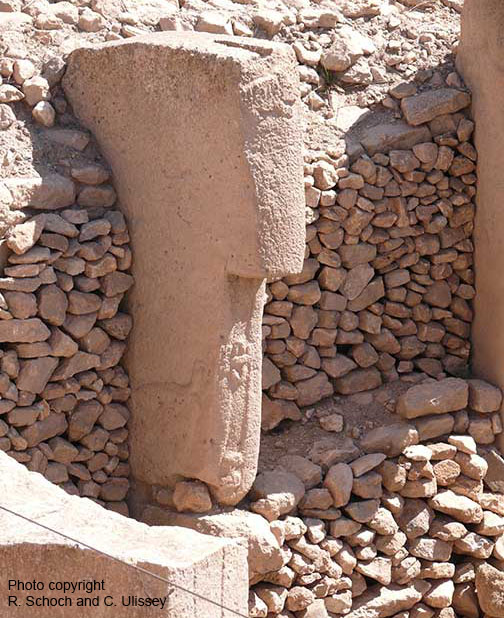
Despite monumental architecture and possible urban settlements, the best argument, for those
researchers who would deny the title of true civilization
to the creators of Göbekli Tepe,
is (or was) that they apparently did not have any form of writing. However, the latest evidence
has completely changed this notion and demands that even the skeptics must rethink the
when
and where
of the origins of civilization.
Ever since I first visited and studied the site of Göbekli Tepe during the summer of 2010, I have speculated that its builders had some form of written notation and communication, if for no other reason than the practicality and feasibility of planning, organizing the labor and crafts specialists, and ultimately constructing such wondrous stone monuments. But the few apparent symbols carved on the stone pillars, in isolation, offer little solid evidence for true writing and literacy. Admittedly, the majority of writing by the Göbekli Tepe people might well have been on perishable materials that have not survived 12,000 years; however, the absence of such physical evidence was pointed to by the skeptics as evidence that writing did not exist (even though this was faulty logic on their part). Now, through the insight of my colleague, Dr. Manu Seyfzadeh, we do have a potential context and comparison for the symbolic notation found at Göbekli Tepe. As Dr. Seyfzadeh noted, some of the symbols at Göbekli Tepe are remarkably similar to the Anatolian Hieroglyphs (also referred to as Luwian and/or Hittite Hieroglyphs) used in the same general region (modern Turkey) millennia later. Is this purely coincidental? We think not. Indeed, we published a technical paper pointing out some major similarities between the Anatolian Hieroglyphs and the symbols carved on some of the Göbekli Tepe pillars (Manu Seyfzadeh and Robert Schoch, Archaeological Discovery, February 2019, volume 7, pages 31-53).
Although there has been much work since, the Anatolian Hieroglyphs were intensely studied
and documented by the linguist Emmanuel Laroche (1914–1991) in his classic book titled
Les Hiéroglyphes Hittites (1960). Laroche assigned numbers to the various Anatolian
hieroglyphs, and attempted translations and interpretations; here I refer to various
Anatolian Hieroglyphs by these Laroche Numbers
(=LN).
The Anatolian Hieroglyphic inscriptions generally date to the second and early first millennia BCE (with many from the period of circa 1300–900 BCE). This is 8000 years or more after the construction of Göbekli Tepe, yet there are remarkable correlations suggesting that at least fragments of a writing system used by the Göbekli Tepe people survived and were incorporated into the system of Anatolian Hieroglyphs, in some cases with various modifications – which is quite understandable, and even expected, over such a vast length of time.
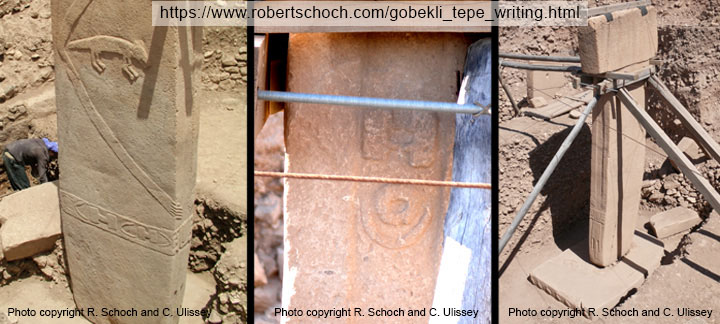
neckregion. Right: Overview image of the entire pillar, which stands approximately 4–4.5 meters high and weighs approximately 10–15 tons. (Photographs copyright R. Schoch and C. Ulissey.)
The first and perhaps most important comparison between the Anatolian Hieroglyphs and
the writing at Göbekli Tepe involves LN 360 and symbols found prominently on the belt
of one of the largest and most magnificent pillars at Göbekli Tepe, that known as
Pillar 18. LN 360 consists of a crescent or C
shape open to the right, followed
(left to right) by two vertical parallel lines followed by a reversed C
or
crescent open to the left. The prominent inscription on the belt of Pillar 18 includes
a C
shape followed by an H
shape followed by a reversed C
shape.
On the front edge of Pillar 28 at Göbekli Tepe the same three symbols, the same word,
is carved vertically. LN 360 can be translated as god
and we (Dr. Seyfzadeh
and I) hypothesize that the C, H, reversed C
at Göbekli Tepe is likewise a
word meaning god
. Even before this suggested translation, there was
speculation that the anthropomorphic pillars (some of the pillars have arms, hands,
belts, and loincloths) were meant to represent gods or a god.
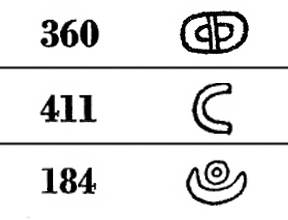
A slight discrepancy between LN 360 and C, H, reversed C
at Göbekli Tepe
is that in LN 360 the middle character consists of two parallel vertical lines rather
than an H
shape. The H
, with either one or two cross-bars (and both
forms, interestingly, appear at Göbekli Tepe), appears in Laroche’s catalog as
Number 239. In Anatolian Hieroglyphs an H
shape may have had the meaning
of a gate
, portal
, or passageway
. This concept of a gate or
passage was possibly associated with a god or with gods, because gods could
control the passage from one realm to another, and in particular control the
passage from life to death and life again, in the case of a belief in rebirth.
And gods would mediate between the earthly and heavenly realms, between the
material and spiritual realms. Thus, the symbol for a gate, portal, or passage,
may have been a simplified emblem referring to gods or spiritual beings, and
H
shapes are found multiple times on a number of pillars at Göbekli Tepe.
In Anatolian Hieroglyphs, the horizontal cross-bar of the H
appears to
have been omitted when used in the word or hieroglyph meaning god
.
Further supporting the association of the H
symbol with god
at
Göbekli Tepe, and also strengthening the link between the Göbekli Tepe writing
and the Anatolian Hieroglyphs, on the top front of Pillar 18 is another set of
symbols consisting, from top to bottom, of an H
(which in this case has
two horizontal cross-bars), a circle with a dot in the center, and a crescent
which is open to the top. The circle with center dot and crescent combination
occurs as LN184 and is considered a symbol of the divine. This may represent
the Sun and the Moon, and more generally the cosmos or heavenly realm.
Alternatively, one might suggest that the circle with a dot in the center
represents all of Earth; if you stand in one spot and rotate through 360
degrees (a full circle) the horizon will appear as a circle around the place
you are standing. Or, the circle with a central dot may represent our Sun, as is
the case with current astrological symbols. (Please see the Addendum at the end
of this article for more on the symbol for the Sun, a circle with a dot in the
middle.) Either way, I hypothesize that LN184 combined with the H
at Göbekli
Tepe is stating that the god in question rules the cosmos, both Heaven and Earth.
Furthermore, the H
with LN 184 could symbolize the gate or portal between
the mundane and the divine, the material and the spiritual, the terrestrial and
the celestial.

Returning to the writing on the belt of Pillar 18 at Göbekli Tepe, the full
inscription on one side is actually C, C, H, C, H, reversed C
(and the
first two Cs
are slightly different from each other, as are the Hs
,
but whether these differences are significant or not remains an open question).
The isolated C
shape, or crescent open to the right, is comparable to
LN 411, which is interpreted as having a connection to dieu
(god).
Personally I speculate that this full inscription may signify god of gods
(and was read right to left in this case). This raises the issue of whether the
Göbekli Tepe people believed in a supreme god presiding over lesser deities.
Were they monotheistic at some level?
An immediate question that I have to ask myself is why symbolize a god, or the
supreme God, as a C, H, reversed C
? And why place God in the sky? (Nowadays
many people simply take it for granted that God, or gods, are located above, in the
heavens – and Heaven has an explicitly religious connotation, but this was not always
necessarily the case.) I believe the answer, and the second message of the LN 360
symbol, lies in plasma physics.
As I have described in my 2012 book, Forgotten Civilization: The Role of Solar
Outbursts in Our Past and Future (a 2nd edition of this book, revised and expanded,
was released in March 2021 with the subtitle, New Discoveries on the Solar-Induced
Dark Age) in circa 9700 BCE our Sun exploded
with
a mighty outburst or series of outbursts (some people now use the terms mini-nova or
micro-nova for these types of stellar and solar phenomena), bringing the last ice age
to a dramatic close as global climates warmed suddenly and precipitously. Furthermore,
I now hypothesize (in the revised edition of Forgotten Civilization) that, based on
the evidence, it was a solar outburst that initiated the Younger Dryas, circa 10,900 BCE,
melting ice dams and glaciers, causing a massive glacial flood that changed ocean
circulation patterns in the Atlantic, thus initiating the Younger Dryas cooling.
Ice and sediment core data record solar outburst events, as does data from our Moon;
however, another interesting line of evidence of our Sun dramatically affecting life on
this planet comes from the preeminent plasma physicist Dr. Anthony Peratt at Los Alamos
National Laboratory (see the illustration immediately below, and also discussion and
references in Forgotten Civilization). In short, Dr. Peratt, aside from studying
the Sun (and more) for the U.S. government, made the astounding discovery that some ancient
petroglyphs, by their diagnostic features, indicate ancient people the world over witnessed
a massive solar event (the charged particles interacting with our atmosphere, as we see
today in the Northern and Southern lights, only so much more intense that the auroras took
on distinctive shapes) and recorded the shapes they saw in the sky on rock. His published
papers offer examples from over 130 countries. A few of the shapes he describes are
stick-figured men with bird heads, stick-figured men with two dots on their sides
(the dots indicating synchrotron radiation), owl-like faces, cascading cylindrical
shapes, and more. I believe it is a reasonable hypothesis to suggest that the people
living during those times reasoned that such events were the acts of gods (or a God).
The H
shape and the C, H, reversed C
together are in fact simplified
representations of what people saw in the sky during the solar outbursts. Pillar 18
and its associated pillars at Gobekli Tepe date, in my assessment, to the period just
before the end of the last ice age (circa 9700 BCE), but the Göbekli Tepe people
retained a collective memory of previous solar outburst events – as shown on the pillars.
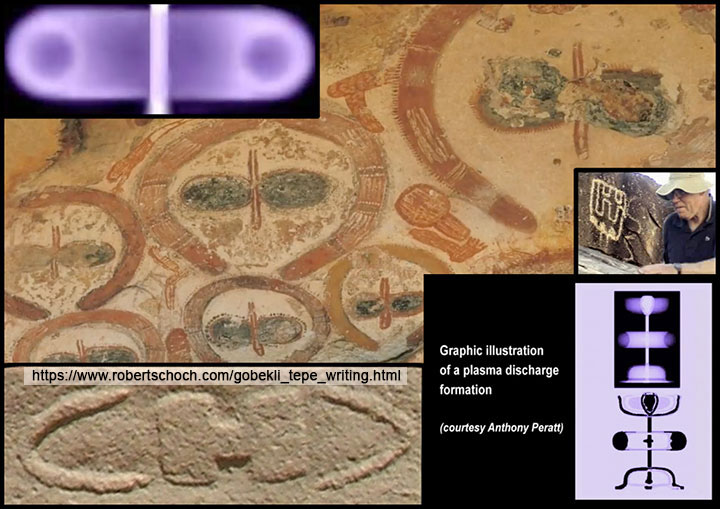
C, H, reversed Con Pillar 18 of Göbekli Tepe. Various rock art from the Kimberly region has been dated to approximately 12,000 years ago, corresponding to the end of the last ice age (D. Finch et al., 12,000-Year-old Aboriginal rock art from the Kimberley region, Western Australia, 5 February 2020, Science Advances, AAAS, 9 pages). (Image of Australia rock art from a screen capture of a video posting, courtesy of Ben Davidson of Suspicious0bservers [https://www.youtube.com/user/Suspicious0bservers; see also the photograph posted on https://www.australiasnorthwest.com/page/kimberley-rock-art]; plasma discharge conceptual images and image of Dr. Peratt, courtesy of Dr. Anthony Peratt; image from Göbekli Tepe, courtesy of and copyright by Robert Schoch and Catherine Ulissey.)
Thus this series of symbols, this word (C, H, reversed C) not only names God, but equates God with the Sun and/or solar activity. Furthermore, the Sun was from the point of view of these ancient people acting as a conscious entity, which I believe is not far off of the mark. Indeed, a strong argument can be made that the Sun and stars are indeed conscious at some level and consciousness pervades the entire universe (see discussion in Forgotten Civilization). Our Sun is composed primarily of hydrogen and other simple elements and particles (protons, electrons, and so forth) that have been demonstrated to contain the ability to encode information. Scientists such as Luc Montagnier, Masaru Emoto, and Cleve Backster have pioneered research in this field. The ancient Egyptians, for instance, believed we come from the Sun and stars, and thence we can return after physical death. And I hold that there is now strong evidence that simple particles (for instance, protons and electrons that make up hydrogen) can encode information – ultimately the stuff of consciousness, with matter arising from, or derivative of, consciousness (see Chapter 14 of Forgotten Civilization for further discussion).
Fundamentally, God is consciousness, and consciousness exists in and is expressed through basic
particles, which in the universe we inhabit take the form of protons and electrons – that is,
hydrogen that composes a large portion of our Sun – and streams of charged particles that
emanate from it and bind the universe (electrical plasma). Here in the earliest known written word,
which means God
, we see these connections.
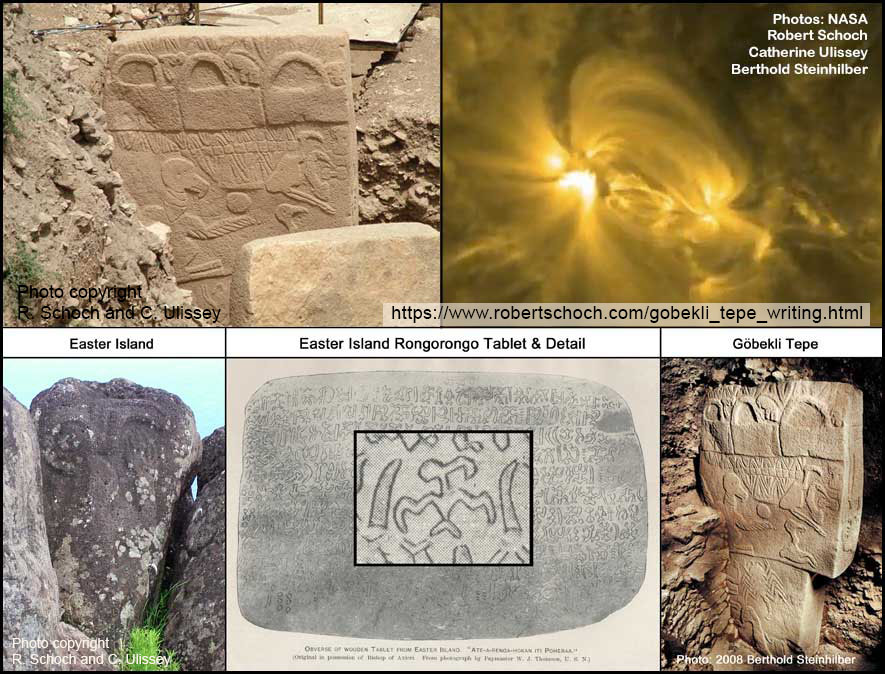
There is more. When we look at Pillar 43 at Göbekli Tepe, not only do we find additional
H
symbols, some of which are flipped by 90 degrees (as is also the case on the front
belt buckle area of Pillar 18), but also at the top of the pillar are three odd images that
look like rectangles with inverted U
shapes on them. To the right of each inverted
U
are different animals (some type of bird, some type of mammalian animal, and
possibly a frog-like animal) jumping down, or sliding down, the up-side-down U
shapes. These carvings have been variously interpreted as representing buildings or other
structures, or as handbags (comparable to a woman’s purse). However, in the context of
Göbekli Tepe and the discussion above, I prefer a different interpretation. The symbolism
along the top of Pillar 43 may represent the electromagnetic and plasma arcing that would
occur on an active Sun. Such arcing is observed on our Sun today, but is not seen without
proper instrumentation (and one should never look at the Sun directly without the proper
protective equipment). During the time of a much more active Sun, as would have been
observed at the end of the last ice age, probably just before and during the solar
outbursts, such arcing may well have been readily seen by many people on Earth (or understood
by the scientists of the time, if we credit these people with the advanced knowledge that
they may very well deserve), and they depicted this activity on Pillar 43. Furthermore, the
jumping
animals may represent the movement and snapping
of the magnetic and plasma
arcs as they form and connect with each other and the surface of the Sun and also give
rise to the ejection of plasma during a solar outburst.
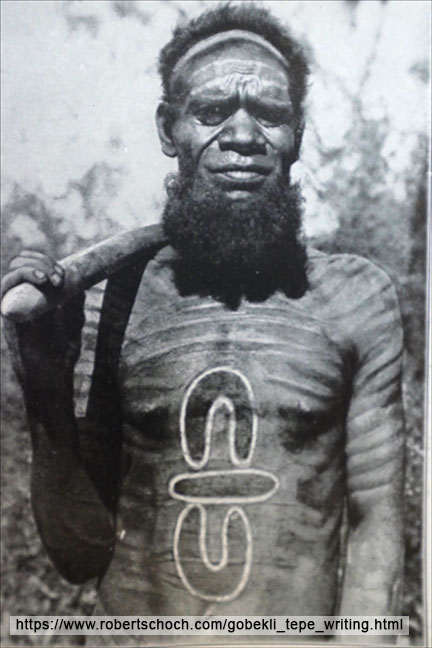
Pillar 43 is sometimes referred to as the vulture
pillar, named after the
prominent bird, generally identified as a vulture, which appears on the pillar. On one
wing the vulture balances a ball
that may represent our Sun. In my research,
I have found that birds and bird-headed humans (bird-men
and bird-women
)
appear prominently in many mythologies. However, these shapes, as cutting-edge plasma
physics now teaches, are also diagnostic of extreme solar events and high intensity
plasma. We see this on Pillar 43 as well as on faraway Easter Island, where my wife
and I have discovered that the Island’s previously unidentified scrip, rongorongo,
is plasma in nature (this discovery was confirmed by a member of Dr. Peratt’s research
team); possibly the written text (or fragments of it, and of course more recent copies
of copies . . .) that records or was inspired by the giant solar event that occurred c.
9700 BCE. Indeed, I find many similarities between the iconography of Göbekli Tepe and
Easter Island. And there are other apparent connections around the world. For instance,
a variation on the Göbekli Tepe word for god, very similar to the form it takes on Pillar
28, appears on the chest of an Australian aboriginal man in a photograph found in the
1922 book by Albert Churchward titled Origin and Evolution of the Human Race
(New York and London, Macmillan Company and George Allen & Unwin; Plate LIX). A variation
on this form is found engraved on an ancient megalith at Knowth (near Newgrange), Ireland.
Interestingly, the petroglyph at Knowth is more scientifically accurate according to
plasma physics, for the core of a plasma torus spins (see image below). And the
prominent “H” found abundantly at Göbekli Tepe is reminiscent of the “H blocks” at
Puma Punku (near Tiwanaku), Bolivia. Were there direct connections between these
areas in ancient times? Are the similarities derived from a common source, or common
knowledge of our Sun, consciousness, and plasma that pervades the universe? I doubt
these shapes found in seemingly disparate locations are all a matter of coincidence.
Rather I believe they reflect shared advanced knowledge, science our civilization
is just beginning to understand.
In the word symbolism found at Göbekli Tepe and other ancient sites, particularly the
C, H, reversed C
and its derivatives, we have two concepts that are combined and
presented: The Sun and God. This is a theme that permeates the ancient world: The Sun
was worshipped as a deity. On a journey to India, Katie and I learned first-hand that
among the Hindu tenets is the belief that the Sun is the one and ultimate God, and
the physical manifestation of the supreme God. Is there a distinct consciousness
possessed by the Sun, the planets, the stars, and even perhaps the constellations
(possibly a collective consciousness
)? To the Greeks, Romans, and many other
ancient peoples, the celestial bodies were recognized as gods (Jupiter = Zeus,
Apollo = Sun, and so on). What then is the C, H, reversed C
symbolism trying
to convey? Why is the T-shaped Pillar 18 at Göbekli Tepe wearing this message? Is
it directing our gaze to Orion, with its prominent belt (see the
SIDA article on this website for more on this particular
branch of my research). Pillar 18 may be intended as a recreation of Orion, the
headless hunter accompanied by the dog
(Sirius, the dog star in the
constellation Canis Major, the greater dog
); on Pillar 18 the dog
is tucked under the right arm. On Pillar 18 the arms, which are spread out in
the actual constellation, are brought down to the sides and the hands frame the
navel region, reminiscent of the moai on Easter Island. The belt of Pillar 18
corresponds to the belt stars of Orion, and the fox-pelt loincloth can be seen
as equivalent to the Orion Nebula which hangs
from the belt in the
constellation. And Orion is surrounded by the zodiac, a series of constellations,
many of which represent animal forms, just as Pillar 18 is surrounded by a ring
of smaller pillars with varied carvings at Göbekli Tepe. This iconography suggests
yet another message that we are meant to discern. Do we, or does our star, have
an umbilical connection to Orion? The Orion Nebula is a birthplace of stars. The
writing and symbolism at Göbekli Tepe is most certainly speaking to us, though its
message may be unclear at this time.

H blocksat Puma Punku, Bolivia. (Photographs copyright R. Schoch and C. Ulissey.)
All in all, I feel confident that the Göbekli Tepe people used written language.
Admittedly, we have only a limited amount of their writing
preserved on the
structures so far uncovered (numerous stone circles identified there via geophysical
techniques remain unexcavated). I predict that this is just the tip of the proverbial
iceberg. I hope that eventually substantial texts from Göbekli Tepe times will be
found. Until then, I am continuing to study the symbols – the writing – from this
early period that have been recovered so far. And to return to the issue of true
civilization
, there is now no doubt in my mind that the Göbekli Tepe people not
only built monumental stone structures and most likely had large settlements that
we should classify as cities, but that they also had the third (and in the opinion
of some scholars, the most critical) diagnostic feature of civilization, namely
writing and literacy. The Göbekli Tepe people were incredibly knowledgeable with
a well-organized and sophisticated society. They possessed a true civilization at
the end of the last ice age – six thousand years before most conventional historians
believe that true civilization first arose.
Addendum: 8 April 2020.
Laboratory experiments have demonstrated that electrical discharge phenomena can produce craters with a central uplift, which creates the impression of a circle with a dot in the middle; this might be viewed as further supporting the plasma and solar outburst correlation to the symbol of this shape found at Göbekli Tepe. One could also view this as the Sun creating its own symbol – leaving its own fingerprint, if you will. However, geology is not so simple. Physical impactors (meteors, asteroids, comets, etc.) can also create craters with a central uplift, and both electrical discharge phenomena and physical impactors can create craters without a central uplift (that is, without the "dot" in the center). As we view it, though, the preponderance of evidence (well beyond this one symbol) points to a connection with the Sun.
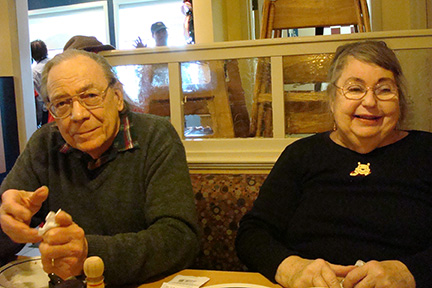
Addendum: 13 May 2020, with my father (Milton R. Schoch) fighting for his life in a hospital in Virginia, having contracted COVID-19, I offer the following.
To address the issue mentioned above as to why LN 360 would be found on the
chest of an Australian aboriginal man: I believe the ultimate message may be, just as
the Ancient Egyptians proclaimed: We become the Sun
(or stars
more generally).
Recent science, as I discuss in my book
Forgotten Civilization and paraphrased
above, demonstrates that hydrogen can encode information. Hydrogen is a major component of
stars and also of life in general, and humans in particular. The human body contains a large
amount of water, and water is H2O. Katie and I speculate that during life the
hydrogen within us encodes information about us and, upon death, because it is a light element
(the lightest on the periodic table), it leaves the body and floats upward to space to gather
into clouds and ultimately works to form stars. This may be sacred science left to us from a
forgotten civilization. Perhaps it is the most important message of all, that upon death we rejoin
the stellar cosmos and the divine.
Addendum: 14 May 2020.
My father, Milton R. Schoch, passed away in the early morning hours today (U.S. east coast time) due to COVID-19 Pneumonia. We loved him, miss him already, and wish him well in all that comes next.
A Postscript:
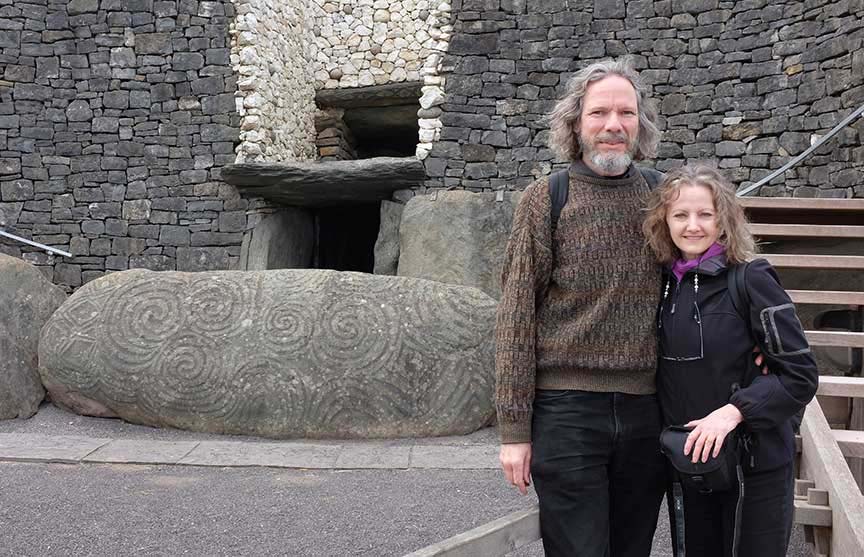
I, Robert Schoch, am the primary author of this article. However, Katie contributed to it greatly in terms of research, contributions to the writing, and editing. As many people know, I began my serious work on ancient civilizations decades ago due to the urging of the late John Anthony West, who asked me to apply my geological expertise to examining the anomalous weathering and erosion patterns on the Great Sphinx of Egypt. Determining that the fundamental (primary) cause was water, in the form of torrential and protracted rainfall, was relatively simple. However, the triggering mechanism – as Katie likes to say, "the culprit behind the ancient demise" (of what not only ended Earth's last ice age but also decimated the high civilizations of the time) – remained a mystery until Katie connected Easter Island's previously undeciphered script to the research of Dr. Anthony Peratt. As I write in Forgotten Civilization, in hearing this revelation I was struck as if by plasma itself. This occurred in 2010. I needed substantially more empirical data before I would go out on a limb in asserting that solar factors ended the Younger Dryas (and thus Earth's last ice age), but I am convinced there is now a plethora of evidence to buttress this limb. This article expresses the thrust of our combined research in the years since.
Katie and I, with the not-for-profit Organization for the Research of Ancient Cultures (ORACUL) are working on a documentary that will include some of the research presented in the article above. If you would like to support this endeavor, please consider donating. And if you would like to see two trailers (plus some production photographs), here is a link. So as to save money in our early stages of production, we did not hire a professional narrator for either trailer. Rest assured we will for the final documentary.
